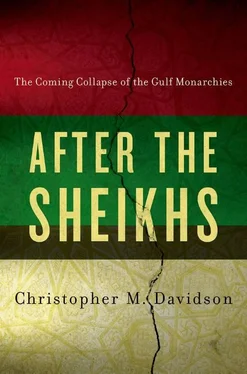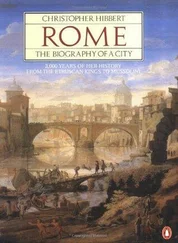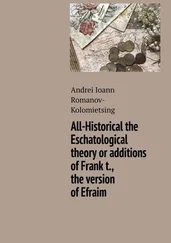Abu Dhabi’s iconic investments in the West are now also numerous, with the Abu Dhabi Investment Company having paid a reported $800 million just before the beginning of the 2008 credit crunch for the famous Chrysler Building in New York — a staple of Hollywood movie Manhattan panorama shots. [374] 66. Agence France Presse, 9 July 2008.
Equally conspicuous, in 2005 the crown prince’s Mubadala Development Company purchased a 5 per cent stake, worth $130 million, in Italy’s celebrated Ferrari car manufacturer. [375] 67. The National , 22 July 2008.
Significantly, this was followed up by Mubadala’s sponsoring of the Ferrari Formula One team which involved the Mubadala logo appearing prominently on the nosecones of Ferrari F1 cars. [376] 68. Emirates 24/7 , 17 March 2008.
Soccer, too, has been a priority for Abu Dhabi, exemplified by the Abu Dhabi United Group for Development and Investment’s purchase of Manchester City Football Club for about $360 million in summer 2008. [377] 69. International Herald Tribune , 2 September 2008.
Led by one of the crown prince’s younger brothers (and a deputy prime minister of the UAE), Mansour bin Zayed Al-Nahyan, the group quickly installed one of the crown prince’s right hand men (who also serves as the chairman of Abu Dhabi’s Executive Affairs Authority) as the club’s new chairman. Mirroring Emirates’ naming of the Arsenal stadium, Abu Dhabi’s airline — Etihad Airways — has now paid $642 million for naming rights for Manchester City’s stadium, which was originally built to host the Commonwealth Games in 2002. The club’s former chief executive officer [378] 70. Garry Cook.
described it as ‘one of the most important arrangements in the history of world football’. [379] 71. As cited by Dorsey, James, Mideastposts , 7 October 2011.
Today, Abu Dhabi’s association with Manchester City is widely reported and discussed in the British newspapers, with its chairman being a frequent subject of articles in the sports supplements.
The other Gulf monarchies have also made high profile purchases in the West, although due to greater caution or more limited resources they have tended to capture less attention. Kuwait’s Investment Dar, for example, currently owns 51 per cent of Britain’s Aston Martin luxury car company [380] 72. The Guardian , 27 September 2009.
—a brand normally associated with James Bond and other British action movies. Even Bahrain has been active, despite more modest sovereign wealth investment capabilities, with the state-backed Mumtalakat Holding Company taking a 30 per cent stake in Britain’s McLaren Group in 2007—manufacturer of the McLaren supercar and owner of the multiple F1 championship-winning McLaren Formula One team. [381] 73. The Daily Telegraph , 10 January 2011.
In 2011 Mumtalakat increased its stake to 50 per cent, perhaps explaining McLaren’s initial reluctance to boycott the 2011 Bahrain Grand Prix following the first wave of protests in the kingdom, as discussed later in the book.
The Gulf monarchies’ hosting of increasingly high profile international sports events can also be considered a component of this strategy, as although these are not directly connected to investments in Western companies and are also intended to contribute to economic diversification (namely supporting nascent tourism industries) in the region, they nonetheless make a strong contribution to the international sports industry and help boost awareness of the Gulf monarchies among primarily western audiences. Alongside Bahrain, Abu Dhabi also hosts an annual Formula One Grand Prix, while Dubai hosts an ATP tennis tournament and European PGA golf tournament, among numerous other events. Qatar’s hosting of the 2022 FIFA World Cup is now by far the strongest example. Having defeated bids from several other countries, including the US and Japan, Qatar has committed to massive spending in order to create the necessary infrastructure for the event, including at least twelve brand new, world class stadiums. It has been estimated that the total cost will be around $211 billion, with $163 billion being spent on the stadiums and $47 billion being spent on transport infrastructure. Thus a decade looms of lucrative contracts for construction companies and sports-related industries, with Qatar likely to keep winning soccerrelated headlines in Western and other international newspapers for years to come. Meanwhile Qatar is also intending to bid for both the 2017 World Athletics Championships and the 2020 Olympic Games. [382] 74. The Daily Telegraph , 8 November 2011.
Offering further evidence of the Gulf monarchies’ soft power strategy has been the increasing number of explicit gifts and donations to institutions and organisations in the West. In some senses, even though these involve wealth transfers from developing countries to developed countries, they can be viewed as a form of development assistance. Unsurprisingly, Qatar has been particularly active in this regard with its ambassador to the US visiting New Orleans in 2006 and pledging $100 million to help the victims of Hurricane Katrina. When asked to explain, the ambassador stated that this ‘wasn’t about improving Qatar’s image in the US… or about public diplomacy’. Nevertheless, Qatar’s gift was one of the largest foreign grants in the wake of Katrina, with one prominent Louisiana observer predicting that ‘the [Qatari] ambassador would be met with lots of questions and praise for his country’s benevolence when he comes to the region’. [383] 75. National Public Radio , 7 May 2006.
But even more directly underlining the emirate’s soft power strategy, when Qatar’s prime minister was thanked by a US dignitary for the gift, he reportedly replied that ‘We might have our own Katrina one day’, [384] 76. Foreign Policy , 12 April 2011.
clearly hinting at Qatar’s vulnerability and potential need for US protection. Another recent example of Qatari development assistance to the West is its setting up of a $50 million fund in 2011 to help young entrepreneurs in Paris’ impoverished and predominantly immigrant North African suburbs or banlieues . Described as ‘part of a broadening effort by the small country to expand its international presence through investment and diplomacy’ the gift is likely to be well received by the French government, which has been accused of abandoning these restive, high unemployment, districts. [385] 77. Foreign Policy , 5 January 2012.
The UAE has similarly been involved in urban regeneration projects, With Abu Dhabi having signed an agreement worth a reported $1.5 billion with Manchester City Council and regeneration body New East Manchester in 2011 to develop an 80 acre site close to the soccer stadium, thus tying in with Abu Dhabi’s ownership of Manchester City Football Club. There are plans to build a cluster of new sporting facilities in addition to a swimming pool with the aim of ‘using sport to inspire and transform the lives of children in an area with massive deprivation — and some of the lowest life expectancies in Britain’. [386] 78. Manchester Evening News , 3 March 2011.
In September 2009, at the exact time when the UAE was waiting for the US Congress to ratify its civilian nuclear deal (which had been delayed due to allegations concerning the Abu Dhabi ruling family, as discussed later), a large donation was made to the Children’s National Medical Center in Washington, DC. Amounting to $150 million — reportedly the largest ever grant given to paediatric surgery — the money has been channelled via the Abu Dhabi government-backed Sheikh Zayed Institute and, according to the Center’s president, will ‘…allow us to serve the world for the next 100 years’. [387] 79. The National , 15 June 2011.
Connecting the strategies of development assistance to the West and support for Islamic credentials, both the UAE and Saudi Arabia have also been building new mosques in Western Europe. Most recently, in late 2010 construction work was completed on Europe’s largest mosque, in the Netherlands, financed by Dubai’s Al-Maktoum Foundation — named after the emirate’s ruling family. Located in Rotterdam, the mosque can accommodate 3,000 worshippers, boasts two fifty metre tall minarets, and also houses a centre for ‘charity, mutual understanding, and forgiveness’. Strongly opposed by Dutch far-right movements, which have stated that ‘this horrible thing doesn’t belong here but in Saudi Arabia’, the mosque is nevertheless likely to prove extremely popular with Rotterdam’s substantial Muslim population. [388] 80. Agence France Presse, 18 December 2010.
Читать дальше












